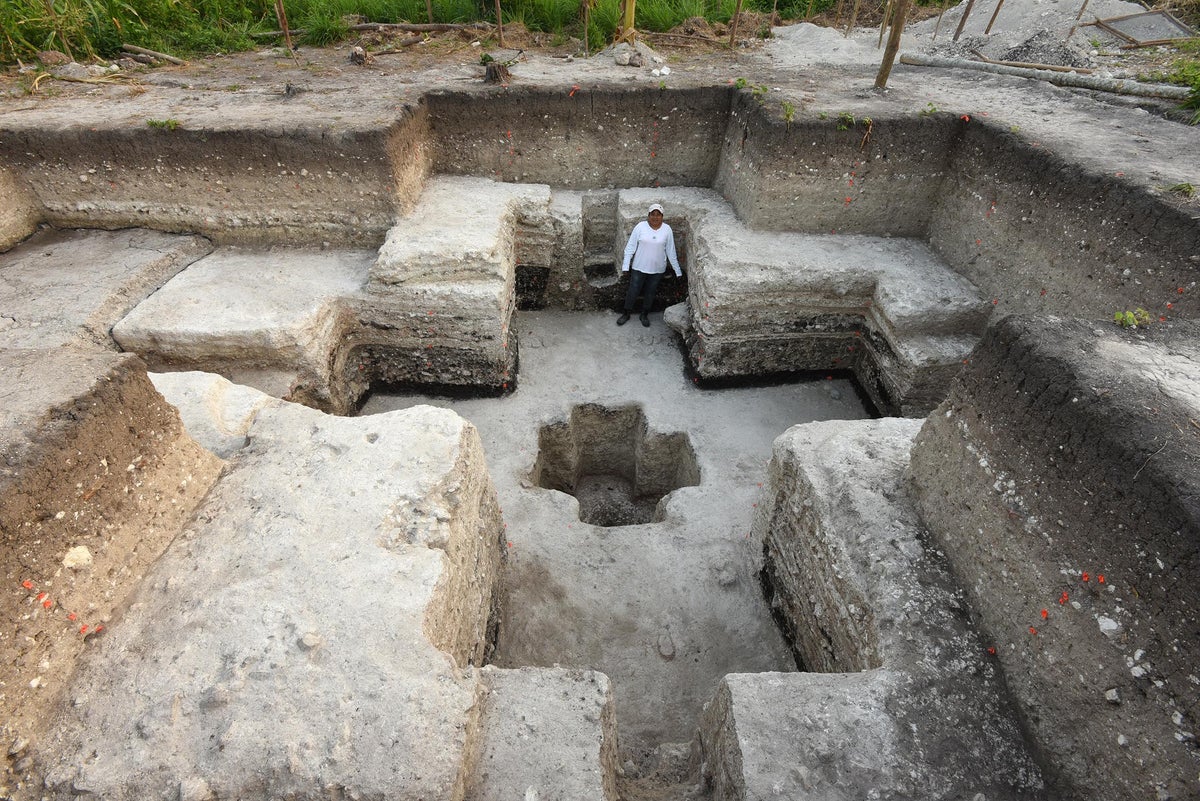A cross-shaped pit found at the Aguada Fénix site in Mexico after excavation.
Inside the pit were pigments of blue azurite to the north, green malachite to the east and yellow ochre to the south, as well as marine shells interspersed with axe-shaped clay offerings to the west, says Inomata, a researcher at the University of Arizona. Later the team realized that the cross-shaped pit was aligned with giant canals that extended toward the four cardinal directions.
The cross and the canals, Inomata says, form a cosmogram—a monumental map of the universe etched into the landscape. Cosmograms were used by Mesoamerican civilizations to represent their understanding and cultural relationship with the cosmos. Inomata says that his and his colleagues’ findings, published on Wednesday in Science Advances, challenge long-held assumptions about the social order of the ancient Maya and the reasons behind their architectural achievements.
If you’re enjoying this article, consider supporting our award-winning journalism by subscribing. By purchasing a subscription you are helping to ensure the future of impactful stories about the discoveries and ideas shaping our world today.
Researchers Takeshi Inomata and Melina García Hernández excavate the cross-shaped pit with pigments marking the four cardinal directions.
Aguada Fénix covers a nearly nine-by-7.5-kilometer area, making it one of the largest ancient constructions in all of Mesoamerica. After its discovery in 2017, the team found that the site dated from between 1000 and 800 B.C.E., long before Maya hierarchies had developed. “The question was ‘Why was it built?’” Inomata says.
The researchers also documented a network of canals and a dam that extended westward from the main plateau; these features were likely designed to channel water from a nearby lake. Though the hydraulic system appears unfinished, its monumental scale suggests an extraordinary level of coordination for its construction, Inomata says.
Pigments of blue azurite, green malachite and yellow ochre respectively mark north, east and south, and marine shells and axe-shaped clay offerings mark west.
Like Inomata and Chinchilla, Stuart proposes that the underground offerings placed around the pit “work as a metaphorical planting, activating the space, which amounted to a cosmic stage,” perhaps for communal gatherings and performances.
For Inomata, the new evidence is a reminder that social hierarchies are not always necessary when a goal serves the common good, such as by allowing for collective ritual. “This is a remarkable achievement of the [Maya] people who still live there,” he says.
If you enjoyed this article, I’d like to ask for your support. Scientific American has served as an advocate for science and industry for 180 years, and right now may be the most critical moment in that two-century history.
I’ve been a Scientific American subscriber since I was 12 years old, and it helped shape the way I look at the world. SciAm always educates and delights me, and inspires a sense of awe for our vast, beautiful universe. I hope it does that for you, too.
If you , you help ensure that our coverage is centered on meaningful research and discovery; that we have the resources to report on the decisions that threaten labs across the U.S.; and that we support both budding and working scientists at a time when the value of science itself too often goes unrecognized.
In return, you get essential news, captivating podcasts, brilliant infographics, , must-watch videos, challenging games, and the science world’s best writing and reporting. You can even gift someone a subscription.
There has never been a more important time for us to stand up and show why science matters. I hope you’ll support us in that mission.
Thank you,
David M. Ewalt, Editor in Chief, Scientific American
Source: www.scientificamerican.com
